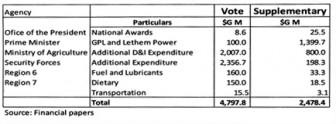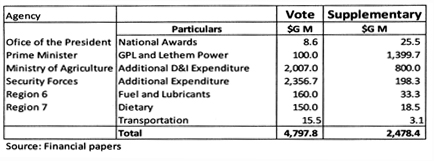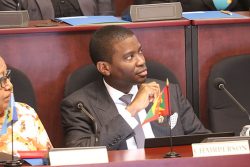Even allowing for the imprecise language, these words appearing in paragraph 3 of the Executive Summary of the Report of the Auditor General 2010 must be very discomfitting to Dr Ashni Singh, Minister of Finance. Not that the sentiment is new; words to that effect have appeared in every single report since Dr Singh was appointed a senior technocratic minister in 2006. But what makes the words perilous for him is that the report, which for four months has been kept secret from MPs and public alike, was tabled in the National Assembly on the same day as were two financial papers (Nos 7 and 8) for $5.7 billion.
In each case of reported abuse in the past, the ministry gave one stock, banal response to the finding by the Audit Office: “that the Ministry of Finance continues to ensure that there is full compliance with the requirements of the Fiscal Management and Accountability Act.” No one can accuse Dr Singh of not understanding the Act and its requirements.
But perhaps he felt, like Steve Jobs, that he could bend reality at his command, or he underestimated the commonsense of Guyanese, or he did not care, assured of the unquestioned support and vote of his parliamentary colleagues and the cover of his former authoritarian boss, President Jagdeo.
Post November 28, that attitude can be fatal. Mr Jagdeo has gone, bequeathing a diminished PPP/C government, taking with him his immunity, and seemingly inured to any embarrassment. To President Ramotar, on the day he delivered his maiden presidential speech to the National Assembly, his Finance Minister tabled two financial papers that have his opponents excited and his own supporters confused. It is the Jagdeo legacy, so faithfully carried out by his protégé and appointee Dr Singh who, faced with criticism, demonstrates misplaced bravado and accuses me of “blatant distortions and misrepresentations.”
Over the next couple of weeks this column will review the report of the Auditor General but given the topicality of the two financial papers, these are addressed in this column.
The two papers
The two papers are respectively for $2.240 B of which $2.161B is for recurrent expenditure and $79.3 M on capital expenditure; and $3.471B, classified entirely as capital expenditure, although there seems to be some element of recurrent expenditure in at least one of the headings. It is probably worth repeating the elements of an occasion that would permit the issue of a warrant by the Minister for expenditure from the Contingencies Fund. Indeed, paragraph 29 of the 2009 and 2010 Auditor General’s reports reminds the Minister that the criteria require him [the Minister] to be satisfied that “an urgent, unavoidable and unforeseen need for the expenditure has arisen (a) for which no moneys have been appropriated or for which the sum appropriated is insufficient; (b) for which moneys cannot be reallocated as provided for under this Act; or (c) which cannot be deferred without injury to the public interest…”
The report adds that “where any advance is made, a supplementary estimate must be laid before the National Assembly as soon as is practicable for the purpose of properly authorising the replacement of the amount advanced.” What the report does not state is that the Minister, when seeking the replacement of funds, must provide to the National Assembly specifics of (a) the amounts advanced; (b) to whom the amounts were paid; and (c) the purpose of the advances. It is safe to say that this Minister has never provided the required information to the National Assembly. And equally significantly, the benign Audit Office never addresses the expenditure under the respective agency programme. Surely advancing the money to the expenditure agency is not the end of the transaction; the money has to be paid out.
Let us take a couple of examples. More than $200 million was spent by way of contingencies advances on Amerindian projects in 2010. There is not a single comment on the expenditure under the ministry. Similarly, $75.5 million was spent out of the Contingencies Fund on completing the swimming pool. Again, no mention under the report’s audit findings at that ministry.
And finally, $300 million was paid out of the Contingencies Fund under Agriculture for expenses described as “to assist farmers in regions 8 and 9 affected by prolonged rainfall.“ That would normally warrant some audit attention; none is suggested in the 2010 Audit report.
Let us now turn to the 2011 advances that have generated such excitement, starting with the Contingencies Fund. Some of the main headings are as follows: 
It is incredible that the budget for national awards should be understated by 300%. The Office of the President has so often and so long operated outside of the already lax financial system that that is now part of its culture. Maybe the October awards were an afterthought of Mr Jagdeo with elections in mind. But Dr Singh, it must be remembered, presented a mid-year report in August and went to the National Assembly for money twice in September. He ought to have known then that GPL and Lethem Power would need substantial additional funds. The same applies to the security forces and their need for supplementary funds to cover additional security duties for the elections. And predictably, the Ministry of Agriculture gets supplementary funds for Black Bush and for Mannarabisi, while two Amerindian dormitories get $18 million in food and $3 million to get the children home for Christmas. Whether it was just poor budgeting or politicking is a matter for speculation.
The second paper
Paper 8 is for $3.471 billion and is made up of four items. These are:
1. Ferries from China
The paper seeks another $2,588 million for the two ferries from China for which Budget 2011 had an initial provision of $366M. There was no comment on this by the Minister in his 2011 mid year report but the capital project profile presented at the time of the Budget had a total cost for the ferries of $3,849 million, all of it to be financed by “foreign loans/grants.” The profile shows the project ending in 2011 and the entire amount should have been taken up at the time of the Budget.
2. Education delivery
The paper seeks approval for $160 million on this $8,943 million project for institutional strengthening of hinterland schools, school facilities, textbooks and child-friendly classrooms. $800M was approved in the 2011 Budget and with pre-2011 spending of $4,063 million, the accumulated sum drawn down at end of 2011 would have been $5,023 million, leaving a large sum undrawn. The project is shown as being financed by foreign loan/grants and comes to an end in 2011.
3. East Bank Demerara Highway Improvement Project
The project profile for this IDB-funded, five year (2011-2015) lane extension from Providence to Diamond shows a total cost of $4,510 million of which $450M was approved in the 2011 budget. The paper seeks another $261 million.
4. Electrification programme
This is listed in the capital profile as a two-year project ending December 31, 2012. It consists of:
● the expansion of the transmission and distribution systems;
● seven new sub stations;
● expansion and upgrading of two sub-stations; and
● installation of a Supervisory Control and Data Acquisition (SCADA) system.
The total project cost is $8,157M of which $1,395 M was spent before 2011 and $2,791M was approved in the 2011 budget. It would seem then that there will be some $1,000 million to be spent to the end of the project in 2012.
Conclusion
There is something fundamentally wrong with the manner of budgeting at the central government level. For example, “foreign loans/grants” is a term of confusion, not clarification. The information in the capital project profiles is unhelpful, and even unusual. It seems strange that the Budget would have had only a small part of the cost of the ferry when it was known that their delivery was scheduled in 2011. The reason it seems is a calculated strategy to mask the deficit at the time of budgeting. There is no reason to budget for part of the vessel – you either take the whole cost or none.
The Minister, as usual, was less than forthcoming in his mid-year report disclosures and projections. He then had another chance when he went to the National Assembly – not once but twice in September 2011. If he knew that there would be some matters of financial significance between the dissolution of the National Assembly and the end of the year, he should have sought to have provisions for those.
A senior minister can hardly admit that he was unaware about some of the party’s elections spending plans, although with Mr Jagdeo no one can be certain. Whatever it is, this Minister’s capacity for good budgeting and responsible financial management is being increasingly questioned.
And on the issue of the Contingencies Fund, his financial papers do not meet the requirements of the Act. Not only, in the words of the Auditor General, is the Minister a serial abuser of the Fund, but he shows some disdain for the National Assembly by his failure to provide it with the details required by section 41 of the Fiscal Management and Accountability Act.
At the wider level, the Jagdeo administration had engaged in a spending extravaganza, financed by borrowings.
So while the National Assembly persuades Dr Singh to bring financial papers in accordance with the law, and to stop the abuse of the Contingencies Fund, it also needs to bring under parliamentary control, our ballooning domestic and external debts.






